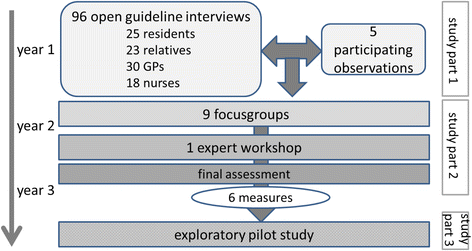Interprofessional collaboration in nursing homes (interprof): development and piloting of measures to improve interprofessional collaboration and communication: a qualitative multicentre study
- PMID: 29325541
- PMCID: PMC5765653
- DOI: 10.1186/s12875-017-0678-1
Interprofessional collaboration in nursing homes (interprof): development and piloting of measures to improve interprofessional collaboration and communication: a qualitative multicentre study
Abstract
Background: Given both the increase of nursing home residents forecast and challenges of current interprofessional interactions, we developed and tested measures to improve collaboration and communication between nurses and general practitioners (GPs) in this setting. Our multicentre study has been funded by the German Federal Ministry of Education and Research (FK 01GY1124).
Methods: The measures were developed iteratively in a continuous process, which is the focus of this article. In part 1 "exploration of the situation", interviews were conducted with GPs, nurses, nursing home residents and their relatives focusing on interprofessional interactions and medical care. They were analysed qualitatively. Based on these results, in part 2 "development of measures to improve collaboration", ideas for improvement were developed in nine focus groups with GPs and nurses. These ideas were revisited in a final expert workshop. We analysed the focus groups and expert workshop using mind mapping methods, and finally drew up the compilation of measures. In an exploratory pilot study "study part 3" four nursing homes chose the measures they wanted to adopt. These were tested for three months. Feasibility and acceptance of the measures were evaluated via guideline interviews with the stakeholders which were analysed by content analyses.
Results: Six measures were generated: meetings to establish common goals, main contact person, standardised pro re nata medication, introduction of name badges, improved availability of nurse/GP and standardised scheduling/ procedure for nursing home visits. In the pilot study, the measures were implemented in four nursing homes. GPs and nurses reviewed five measures as feasible and acceptable, only the designation of a "main contact person" was not considered as an improvement.
Conclusions: Six measures to improve collaboration and communication could be compiled in a multistep qualitative process respecting the perspectives of involved stakeholders. Five of the six measures were positively assessed in an exploratory pilot study. They could easily be transferred into the daily routine of other nursing homes, as no special models have to exist in advance. Impact of the measures on patient oriented outcomes should be examined in further research.
Trial registration: Not applicable.
Keywords: General practitioners; Interdisciplinary communication; Nursing homes; Physician-nurse relations; Primary health care; Qualitative research; Residential facilities.
Conflict of interest statement
Ethics approval and consent to participate
In each of the locations, the respective Research Ethics Committee approved the study (University Medical Center Göttingen Reference Number 17/5/12; Ethics Committee of the Medical Association of Hamburg Reference Number MC-241/12, Medical Faculty Mannheim/Heidelberg University 2012-337 N-MA).
We obtained written permission from all nursing homes included in the study: from nursing homes where we conducted interviews with residents, relatives or nurses, from nursing homes where we conducted participating observations, and also from the four nursing homes of the pilot study.
We moreover obtained written consent from all participants of interviews, focus groups and the expert workshop.
We obtained written consent from all persons involved in the participating observations: nurses, GPs, residents and relatives (if present).
We obtained informed written consent from all interviewed persons in the pilot study (nurses, GPs, resident, relative).
Consent for publication
Not applicable.
Competing interests
The authors declare that they have no competing interests.
Publisher’s Note
Springer Nature remains neutral with regard to jurisdictional claims in published maps and institutional affiliations.
References
-
- Statistische Ämter des Bundes und der Länder: Demografischer Wandel in Deutschland: Auswirkungen auf Krankenhausbehandlungen und Pflegebedürftige im Bund und in den Ländern. Heft 2. 2010.
-
- Zwarenstein M, Goldman J, Reeves S. Interprofessional collaboration: effects of practice-based interventions on professional practice and healthcare outcomes. Cochrane Database Syst Rev. 2009;3:CD000072. - PubMed
-
- Van den Bussche H, Weyerer S, Schäufele M, et al. Die ärztliche Versorgung von Pflegeheimbewohnern in Deutschland – eine kritische Würdigung der vorliegenden Studien. Z Allg Med. 2009;85:240–246.
-
- Statistisches Bundesamt. Pflegestatistik: Pflege im Rahmen der Pflegeversicherung, Ländervergleich – Pflegeheime 2013. Wiesbaden: Statistisches Bundesamt; 2016. https://www.destatis.de/DE/Publikationen/Thematisch/Gesundheit/Pflege/La.... Accessed 12 Dec 2017.
Publication types
MeSH terms
LinkOut - more resources
Full Text Sources
Other Literature Sources
Medical


